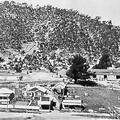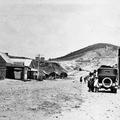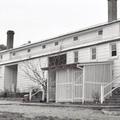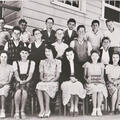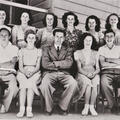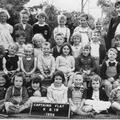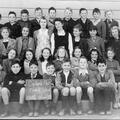< Early Canberra Government Schools
Captain's Flat [1884 - 2017]
A mining town school
The settlement of Captain's Flat grew from a jumble of mining tents and huts after the Molonglo River goldfields were proclaimed in 1882, its township forming close to rich lodes of gold and silver. The town's development drew mainly on employment in company mines, which also extracted copper, lead, zinc and iron pyrites as the first minerals declined. A typical rough and ready mining town boomed in the 1880s and 1890s, then suddenly shrank in the early 1900s as the richest ores ran out and the copper market collapsed.
Captain Flat's first school opened in July 1884 on a house-to-house basis with James Dwyer the teacher. He taught at the homes of Mrs Harrison (Captain's Flat), Mr Bladen (Rock Farm) and Mr Roach (Bollard's flat). Each home provided a room for classes, table and chairs for the pupils, and a paddock for the teacher's horse. At each house he taught 4 or 5 children.
Due to the mining boom Captain's Flat had 50 children of school age by 1886, which led to requests that a public school be opened. When a citizens' petition to this effect reached the area's school inspector, Mr Kevin, he saw the need for a school but had reservations about the Education Department building one, given the usual course of mining booms: -
'If the silver and copper lodes hold out the locality is likely to be permanently inhabited: if not, then the present population will of course leave. At present things look promising. Three to six months will test the permanency of the population. For this period the school might, I think, be carried on in the premises offered by William Martin for which he asks a weekly rental fee of 12/-. It would be well therefore, I think, not to be in a hurry over the erection of new premises.' - 6th July 1886
(All Dept. of Educ. records quoted are from Susan Stanton, Captain's Flat Public School 1884-1984. For the original school files: 5/15293.1, 5/15293.2, NSW Records)
The local Progress Association Committee took a different view. They accepted using rented premises but opposed the use of Martin's building, arguing he was proprietor of the adjoining Captain's Flat Hotel, an undesirable proximity given the language that might be heard. It was also pointed out that the building was a low lying slab hut, subject to muddy surrounds in wet seasons, and that it was unhealthily close to fumes from a mining furnace. But when they proposed that the Department rent a superior weatherboard building they had purposely built for a school, Inspector Kevin demurred, informing his chief inspector: -
'I would not have anything to do with the Progress Association's selection (1) because the building is not central; and (2) because the rent is exorbitant – 52 pounds per annum. The building selected by me will meet the needs of the place till it has clearly been seen if the population will remain; it is, besides, central and the rent asked - 12/- per week – is reasonable. There is nothing in its proximity to the public house, the Progress Committee are its best supporters, and surely they wouldn't use bad language or misbehave.'
The inspector prevailed. Mr Martin's slab building became the town's first schoolhouse in July 1886. It was furnished with 6 cedar desks, each 7½ feet long, 6 forms for seating, a book press, teacher's table, and 2 Austrian chairs. Mr John Filshie, appointed teacher-in-charge, registered 18 boys and 9 girls initially; however this number quickly increased to 40, with an average attendance of 34.1.
Complaints about the school's sub-standard building resulted in a move to new premises in February 1887, still rented due to uncertainty about the future of mining. Within a year, however, mining prospects were sufficiently positive to justify building a permanent school. The site dedicated on 11th January 1889 fronted Schardt Street between Newman and Montgomery Streets, near the centre of town. Plans catered for a single 36 x 21 foot schoolroom with tiered desks and an open fireplace. A tender of ₤596 was accepted and the building completed in 1889. As there was no teacher's residence provided, Mr Filshie and his wife rented a cottage nearby.
The school was designed for 80 pupils and when enrolments rapidly exceeded 90, Elizabeth Deer was appointed assistant teacher. By 1889 the number of pupils reached 126, making more room space imperative. Once approval was sought and granted, the length of the school was extended 14 feet, creating an extra room for junior pupils. Along with a weather shed, it was built during the summer school holidays in January 1890.
Staffing changes and challenges, 1890 - 1902
After four difficult years at Captain's Flat, John Filshie requested a transfer, stating in particular that his two young children suffered croup attacks from the sulphur fumes. The Department declined his request, but transferred Miss Deer when she completed her pupil-teacher training and sought a permanent position elsewhere. Kate Walsh replaced her in 1891. In the same year, Mr Filshie was promoted from Class 2b to Class 2a for good service.
In her second year at the school, Miss Walsh fell seriously ill and had some weeks of sick leave - giving credence to Mr Filshie's concerns about health damage from the sulphur fumes. (The same air pollution also killed all the local trees). Miss Walsh served three years at the school then transferred to North Goulburn Superior Public School in April 1894.
John Filshie was finally allowed to transfer in August 1893. His replacement, Edward Keys, arrived at the time of an ownership dispute over the rented teacher's residence, so he elected to rent elsewhere. When the Department was notified about this, it accepted the move but was displeased when informed that higher rent was due. Some tension also developed over staffing. As enrolments soared, Mr Keys requested an extra teacher, but had to cope quite a while before average attendances met the Departmental ratios for one to be appointed.
As it happened, there were enough pupils in 1897 to warrant two extra teachers: Miss Swan and Mr Studley Lush being duly appointed. Shortly after she arrived Miss Swan fell ill, and when seeking sick leave she too claimed that the fumes were damaging her health. Another health challenge for the whole school was a scarlatina epidemic in April 1897, during which the school briefly closed.
By May 1897, Miss Swan could no longer tolerate the town's unhealthy environment and gave a month's notice of resignation. A much liked teacher, she was farewelled at a school concert held on 3rd June - as reported in Goulburn Herald : -
'...The first part was opened by Mr Hudson playing an overture in his usual accomplished style. This was followed by the song 'Love at Home' by the junior pupils. The singing of the little ones showed the care and skill of Miss Swan....A duet 'I Don't Want to Play in Your Yard' by two little school mites, Misses K Devlen and Millie Martin, was received with uproarious acclamation. Then came a very pretty sight, about thirty little girls dressed in white with sashes to match, went through various forms of sleigh and flag drill with credit to themselves and Miss Swan.
...(in closing) Mr Keys thanked the audience for their support; also Mrs Goggin for free use of the hall and piano; and especially to Miss Swan for her services. ... Two of the senior girls, called upon the stage by Mr Keys to read an address to Miss Swan ... presented her with a beautiful clock of choice white Sicilian marble as a small token of the pupils' respect and esteem. Miss Swan, who was visibly affected, asked Mr Keys to reply on her behalf. The National anthem brought a pleasant evening to a close.' (Trove: Gouburn Herald, 11 June 1897)
To address overcrowding, a second school extension was approved in 1897: 36 x 21 feet in size, on the northern end of the building. However its construction disturbed teaching, as referred to by Mr Keys when he was called upon to explain why only 5 out of 13 students had passed a school certificate. He replied to the district inspector at Braidwood as follows: -
'1. Of the 8 pupils who failed one had only been attending this school for a period of
14 days at the time of inspection, having previously attended the Braidwood
Superior School.
2. Three others who failed live between 4 and 5 miles distant from the school, and
consequently their attendance is most irregular .
3. Owing to the crowded state of the school necessitating me to teach in the
weathershed, cloakroom or anywhere I could place the pupils, and the insufficient
teaching staff; but above all, the incessant hammering, planing, sawing etc carried
on by the contractor in erecting the new additions and in making repairs to the old
building, it was a matter of impossibility for the teaching staff to impart instructions
to the pupils with satisfaction and beneficial results.'
In February 1898, Miss Sarah McInnes was appointed to Captain's Flat after finishing her pupil-teacher training at Braidwood Public School. Seemingly very talented, she took a leading role in preparing the school concert in August that year, assisted by her colleagues, Miss Fraser and Mr Lush. As reported in the Queanbeyan Age, the most popular items were 'Rock-a-bye Baby', sung several times by the smaller girls, some comic songs sung by Mr Lush and a splendid rendition of 'Mulga Bill's Bicycle'. At the closure, headmaster Keys thanked the audience for their support and announced that the proceeds would fund a fence for the young trees recently planted at the school in celebration of Arbor Day.
(Queanbeyan Age 20 August 1898)
Around 1900 the copper market collapsed, Captain's Flat mines were mothballed, and the school's enrolment rapidly decreased. Facing loss of salary, Mr Keys applied for another position, citing his 18 years teaching service and a family of 7 children to support. But no transfer was offered. Then in 1900, the district inspector censured him for failing to keep the school's banking accounts in order. This led to an unexpected visit from the Goulburn area inspector, Mr Flashman, who wrote a strongly worded criticism of the school. He reported arriving during a most incompetent singing lesson, found the classroom 'dirty in the extreme', the floors 'unwashed for months', and 'Mr Keys himself quite in keeping with his dirty surroundings. To say the least he was not clean and his clothes would have disgraced an ordinary swagman'.
Called upon to respond to the Department, Mr Keys defended himself indignantly - but most unwisely, in questioning not only the inspector's judgement but also his own capacity to do better: -
'I am sorry to admit that I cannot give a good singing lesson. It is a failing I am most conscious of, and, to a certain extent, I must admit, impairs my efficiency as a teacher; but I do my very best. But when Mr Flashman states that the lesson was unprepared, I respectfully submit that he arrogantly assumes a state of affairs contrary to fact. I never have, nor ever do give a lesson on any subject without diligent preparation and I still most respectfully submit, with all due respect to Mr Flashman, that there was no evidence that the lesson in process was unprepared. Permit me also to say if Mr Flashman is so infallible and immaculate why should he not give the keynote to such a simple, homely song as "Home Sweet Home". But no: he admitted in presence of my class an inability to do so.'
With regard to cleanliness, Mr Keys pointed out that dust storms were a daily, if not hourly, occurrence at Captain's Flat, and that a fine powder accumulated on all clean surfaces at an alarming rate. He also strongly disputed the inspector's remarks about his personal appearance, complaining that they were 'most insulting, gratuitous and unmerited.'
Predictably, the Department instigated a thorough investigation of the conduct, efficiency and administration of Captain's Flat School. In the process, a discrepancy was found between the money Mr Keys received for school cleaning, and what he paid the cleaners: it was discovered that his daughter was helping to keep the school tidy, for which some of the cleaning allowance was being paid to her. This especially put Edward Keys' career in jeopardy. In October 1902 he was dismissed from the Public Service.
When news of the Department's decision spread through the town, a petition for his reinstatement was organised and forwarded to the district inspector at Braidwood. The Braidwood inspector, being more familiar with the school, considered dismissal too harsh a punishment for a man with so much previously satisfactory service and a large family to support. Finally, Mr Keys made his own desperate appeal to be reinstated, even to the lowest position offered, on grounds he could find no other employment, and his family was suffering severe hardship. However the decision stood. Doubtless he long regretted his intemperate response to Mr Flashman's report. He had served nine difficult years as headmaster of Captain's Flat School.
The post-boom years to 1940
When Captain's Flat mining ceased in 1899, the population plummeted and the town fell silent. At the school, enrolments rapidly declined – from well over 100 to only 34 in 1904. George Spaull, who replaced Edward Keys as teacher-in-charge in January 1903, held the position for seven years. During this time, pupil numbers recovered sufficiently for a second teacher to be appointed. However it appears that a depressed air pervaded the town, made all the worse by its degraded environment. Mr Spaull once commented, regarding the need for a better teacher's residence: 'Wedged in as one is, with bare and uninviting hills, the lot of a teacher's wife and also of the teacher himself is...far from being an enviable one...(given) the monotony of existence in such a gloomy and unsightly spot.'
In 1907, a severe influenza epidemic forced Mr Spaull himself to take sick leave. At the height of sickness, only 12 out of 78 pupils were attending. The next year there was unusually heavy rain, completely flooding the low-lying schoolground. As the grounds had often flooded, though to a lesser extent, Mr Spaull managed to have some drains installed to mitigate the problem in 1908. He finally obtained a transfer in February 1910, replaced by Walter Young, who held the position 18 months until June 1912.
The next teacher-in-charge, Charles Sherwin, had two sons who enlisted to serve in the Great War of 1914-18. In February 1916, his younger son, Roland, wrote a long letter home about his experience at Gallipoli. Being so vividly and finely written, his father had it published in the Braidwood newspaper. Regarding the Anzac evacuation in December 1915, Private Sherwin wrote: -
'Along every path leading to the beach thousands of Australians, New Zealanders and Ghurkas were pouring, while behind, those gaunt, bleak, and barren hills ...rose black against the sky. The embarkation was magnificent ... It seems almost incredible that 30,000 men were removed that night with but four casualties. Gradually the Turkish firing in the distance grew fainter, and our ship was moving slowly through the water, and then it was "Good-bye to Anzac Cove." '
(Trove: Braidwood Dispatch and Mining journal, 18 February 1916)
By contrast, the Sherwins received a heartbreaking telegram six months later about their other son - as a Goulburn newspaper reported: -
'The sad intelligence has been received that Pte Harold Sherwin, late schoolteacher at Mount Fairy, has been killed in France. His father is teacher in charge of Captain's Flat Public School. Pte Harold Sherwin who was 24 years of age, was his eldest son, and was unmarried. A brother is at the front with the Light Horse. The late Pte Sherwin was highly esteemed at Mount Fairy, and received a presentation from the parents prior to his departure. On Friday the pupils of the school sent their condolences to the bereaved parents.' (Trove: Goulburn Evening Post, 12 August 1916)
The next news, however, was remarkable. To everyone's joy, Charles Sherwin and his wife learned from their son's own letter that he was alive: a prisoner-of-war in Germany. Released after the signing of armistice, Harold Sherwin arrived at Bungendore in May 1919, to a warm welcome from many friends and well-wishers. (Trove: Queanbeyan Age, 27 May 1919)
Former students of Mr Sherwin recall lightening their schooldays with pranks. The boys would dunk the ends of girls' plaits into inkwells and catapult wads of blotting paper at each other with wooden rulers. If caught in the act, Mr Sherwin would pull their ears, 'fairly lifting them off their seats'. He was remembered, however, as 'a good bloke', quite unlike his replacement Frederick Cleaver, an extremely strict headmaster. After more than two years at the school, however, it is evident that Mr Cleaver's stern discipline was costing him as much emotionally as any hurt suffered by the pupils. Requesting transfer in 1924, he wrote to an inspector: -
'I desire to inform you that the continuous strain of endeavouring to bring this school to a reasonable standard has severely affected my health. During the past six months I have suffered from insomnia, and for many nights in succession I cannot sleep more than 2 or 3 hours. This affliction has caused me to think seriously of resigning.'
The school had another serious health scare in 1927, when diphtheria swept through the town. The school had to close for a time when the teacher-in-charge, Frederick Rudd, lost a son to the disease. Mr Rudd and family left Captain's Flat not long after this tragedy.
As elsewhere, the town struggled through the 1930s Depression; then began to see a better future driven by new interest in reopening the mines. It was estimated in 1937, for example, that 5 million tons of ore needed only a rail link to Bungendore to be a viable proposition. A bill to achieve this was ratified in late 1937, and in January 1939 the first ore left Captain's Flat by rail. The township was literally 'in business' again.
In full swing: 1940 - 1962
Over the two decades after 1940, the school's growth matched then exceeded that of the 1890s boom. Thirty-four students in 1935 grew to 189 in 1940 and peaked at 387 in 1960. The first portable classroom arrived in 1938, followed by numerous rooms for manual arts, sewing and home economics, a library, staffroom, etc; all essential once Captain's flat became a central school (with secondary students) in 1945.
One headmaster of note was Alfred Wood BA, who transferred from Goulburn South Public in January 1938. To begin with, Mr Wood had only a first-year teacher, Mr S Johnson, as his assistant. Then when Dorothy Cleaver was appointed in April that year, she took charge of a first class of 45; Mr Johnson taught a 2nd / 3rd composite of 52; and Mr Wood took charge of a 3rd / 4th / 5th composite of 56 – in addition to running the school!
Alfred Wood enlisted at the outbreak of World War 2, partly motivated by a Mary Gilmore poem he read in an Australian Women's Weekly journal. It was a full-page spread, with rousing pictures of pioneering farmers and stockmen and Anzacs landing at Gallipoli. Many years later, for the school's centennial book in 1984, he recounted how he had read this poem to the pupils, the week he left the school : -
'I wonder if any (ex-pupils) remember the sunny day in June 1940, when the pupils went with me to the top of the ridge on the eastern side of the town. Up there I read to them Mary Gilmore's poem "No Foe Shall Gather Our Harvest", that had just been published in one of the weekly magazines. At the end of that week I left them to go into the A.I.F.' (Susan Stanton, Captain's Flat Public School, 1884-1984, p.3)
To better imagine Mr Wood's patriotic rendition for the assembled pupils, the poem's final verse reads as follows: -
'We are the sons of Australia,
Of the men who fashioned the land,
We are the sons of the women
Who walked with them, hand in hand;
And we swear by the dead who bore us,
By the heroes who blazed the trail,
No foe shall gather our harvest,
Or sit on our stockyard rail.'
In 1949, the growing school sought extra space through moves to have its grounds extended by two acres; the first students took leaving certificate subjects in 1951; and in February 1954 the Goulburn Post announced that the whole school had an exciting day ahead: some 400 pupils were to take a special train to Canberra to see Queen Elizabeth – carrying three meals each, as they weren't due back at Captain's Flat until 2 am the next day.
In October 1954, principal D. Sutton announced that someone about to begin her first teaching appointment was none other than Miss Lorna Jermyn, one of the first students at the school to undertake the leaving certificate. She had successfully finished her training at Wagga Teachers College and was returning to her old school as a beginning teacher.
Six years later, this writer (Keith Amos) also began his teaching career at Captain's Flat. I don't recall, however, meeting Miss Jermyn. After completing the leaving certificate at Manly Boys High, I trained for two years at Bathurst Teachers College, and was 18 when a telegram arrived in January 1960, appointing me to Captain's Flat. Two weeks later I was packed and ready to go – with one teaching aid in my case, a blue-bound tome we called the 'Blue Bible'. This was the Department of Education's complete Curriculum for Primary Schools. The train I took left Central Station at 8.45 pm and stopped all stations to Bungendore, arriving there at 3.30 am. The branch-line rail motor I switched to, arrived at Captain's Flat terminus at 5 am.
My first impression was that it looked (after Manly) a dreary place. The train creaked slowly in, past huge slag heaps looming darkly beside the rail. As instructed, I proceeded to the bachelor miners' quarters where single teachers boarded. The room was small and plain, shared with another, with steel lockers for belongings. The next day I went to the school and introduced myself to the friendly principal, Lewis Ellem. I tried not to look too dismayed when told that my class was kindergarten - as the teaching course I had taken was for grades 3-6 Primary, not Infants.
The first day's teaching was as traumatic for the children as it was for me - some were constantly crying and 3 or 4 tried to make a bolt for home. I survived three weeks, then had an unexpected reprieve: a married teacher from New Guinea needed placing and his wife was given my kindergarten. A telegram told me that I was being transferred to a 4th Class (one-teacher) school called The Mullion. But as Mr Ellem could find no record of it, I phoned head office in Bridge Street Sydney and was told to return there for instructions about its whereabouts. This lack of records, I learned later, was because my new school had only been open six months. I duly found my way to The Mullion (a property out of Yass) and had two enjoyable years at the local community's small bush school.
Back in Captain's Flat, history repeated itself: lodes were exhausted by 1962 and the mines were shut down permanently. Once again school enrolments plummeted: from nearly 400 in 1960 to about half that three years later. It was the beginning of a transition towards the more peacefully rural character of Captain's Flat today.
A rural quiet descends - post 1962
As six decades of growth and development went into reverse, the school's parents and citizens tried to resist a matching decline of teaching courses, facilities and staff. This occurred in the 1970s especially, strongly supported by the teachers. In 1971 and again in 1976, parents and teachers tried to stave off the closure of the school's secondary division, but as its enrolment figures were so reduced by 1980 (averaging only 16) it was no longer viable.
Another dispute with the Department arose in 1977, spreading within weeks across the state. It began in February when Captain's Flat learned that it was about to lose one teacher out of four because the primary section's 93 children was 3 'under quota'. In protest, the school staff went on strike twice in February, backed by the parents who stepped up the pressure with a boycott, keeping their children away from school one day a week. When the Teachers Federation union looked set to spread this action across the state because of similar situations in other schools, the Department capitulated. It was announced after a state review in April that 87 schools would get an extra teacher under a new teacher/pupil ratio. Captain Flat's was jubilant: they had kept their teacher and helped many other schools to keep theirs.
When its secondary division ceased in 1979, Captain's Flat reverted from central to public school status, staffed by two full-time primary teachers and a resource teacher. It has operated much the same ever since. At the school's 125th Celebration in 2009, festivities continued well into the evening: a 'spit roast', dancing, and a boisterous rendition of 'The Miners Song' towards the end. Some 130 attended, including past principals, teachers, parents and pupils. As the evening wore on, emotions and memories were strong: 'I really hope things don't change too much,' the principal, Peter Cox observed, 'as the present buildings and those who attended this fabulous little school, will continue to tell wonderful tales for many years to come.'
(www.captainsfl-p.schools.nsw.edu.au/news/125-years-of-education?pparam&old)
(Contributed by Keith Amos. He acknowledges especially the fine research by Susan Pryke (nee Stanton) cited above, which has guided this study in large measure)
Lorna Boutland [née Jermyn] – from pupil to teacher
Lorna Jermyn is the great granddaughter of one of the early Eden/Monaro pioneers, Benjamin Jermyn. Born in Norfolk, England, he and his family arrived in Sydney aboard the sailing ship 'Kate' on the 18th of October, 1852 as an assisted immigrant to New South Wales.
At the time of Lorna's enrolment at the Captain's Flat Central School in 1941, her father Roy was working at the Lake George mine as well as running the family farm 'Springbank', about five miles out of town by road. Roy would drive Lorna, her sister and two older brothers to the school on his way to work, long before classes started. In winter the boys, among the very first arrivals, took on the task of lighting one or more of the wood fired cast-iron heaters in the classrooms.
There were times when Roy was unable to take them and on those occasions they walked across country, two and a half miles through the neighbouring Strudwicke property, a route much used over the years, either on foot or on horseback. In later years, particularly when she returned as a teacher, Lorna often rode her horse, Jimmy, to her Aunt Clara Blinksell's place, not far from the school. Jimmy amused himself at Auntie Clara's place for the day while Lorna was instilling the three R's into the local children. An altitude of close to three thousand feet ensured regular winter snow and on a rare occasion the farm was snowed in for a day or so. But snow did not usually deter them. On at least one occasion, Lorna, as the youngest, was taken to school by this route on a sled drawn by the other children.
In the first few years of Lorna's time at the Captain's Flat Central School students were unable to progress beyond the Intermediate Certificate; no pupil was educated to university entrance level. A change of headmaster and an increased number of professional employees at the mine were instrumental in changing that. Doug Sutton, whose daughter Helen also attended the school, took pupils on to the New South Wales Leaving Certificate; Lorna and a handful of others were the first to do so. Since Mr. Sutton was the only teacher to work at that level the range of subjects was necessarily limited but In 1952 Lorna passed her Leaving Certificate with an A in Modern History and B's in English, General Mathematics and Art; a tribute to Sutton's skills and dedication, as well as her native intelligence,
Attracted to the idea of becoming a teacher herself, Lorna successfully applied to the Education Department for a Teacher's Scholarship and in the following entered Wagga Wagga Teachers' College, graduating from there two years later, in 1953.
Journeys to and from home during holidays were made by train in three stages, changing at Goulburn and Bungendore, with the more or less inevitable waiting between trains. Wagga and Goulburn are on the main line between Sydney and Albury. Bungendore is on the line that in those days went from Joppa Junction south of Goulburn all the way to Bombala, almost to the Victorian border. Most of the journey was by steam train but a single carriage railmotor covered the twenty-one miles and eleven-point-two-five chains between Bungendore and Captain's Flat. The line was unfenced and went through farm properties, forcing the driver to slow down and toot the horn from time to time to disperse sheep or cattle that had strayed onto the line. The driver also had to get out to set and reset the points in order to take the branch line to the Flat.
Teachers whose training was paid for by the New South Wales Department of Education could not pick and choose the schools they were allocated to but were allowed to submit their preferences. Lorna's were many, but did not include Captain's Flat. Captain's Flat was where she was sent!
So it was that as Keith Amos (above) wrote:
In October 1954, principal Doug Sutton announced that someone about to begin her first teaching appointment was none other than Miss L Jermyn, one of the first students at the school to undertake the leaving certificate. She had successfully finished her training at Wagga Teachers College and was returning to her old school as a beginning teacher.
It should perhaps be remarked that Miss Lorna Jermyn, although she put her heart and soul into her work, did not much appreciate the appointment. Back in a school as a teacher where two years earlier she had been a pupil seemed somehow incongruous. It was good to be working with her old mentor, Doug Sutton but she found her new role amongst children who knew her as one of them and parents with whom she was now on equal terms a little disconcerting. At the end of 1954 she applied for a transfer to Sydney where her sister Edna now lived. She was posted to Bass Hill, cycling distance from Edna's place at Moorebank where she boarded. It was there that in due course she met and married the fortunate author of this brief memoir.
(Kindly contributed, with photographs, by John Boutland)
Location Map
Related Photos
Teachers
- Dwyer, Mr James
07/1884 - 07/1886 - Guerney, Mr Samuel
07/1886 - 08/1886 - Filshie, Mr John
08/1886 - 08/1893 - Keys, Mr Edward
08/1893 - 10/1902 - Spaull, Mr George
01/1903 - 02/1910 - Young, Mr Walter
02/1910 - 06/1912 - Sherwin, Mr Charles
10/1912 - 08/1920 - Haines, Mr William C
09/1920 - 12/1921 - Cleaver, Frederick W.
01/1922 - 08/1924 - Rudd, Mr Frederick
08/1924 - 04/1927 - Pembroke, Mr Masson
04/1927 - 12/1934 - Browne, Mr Cecil P.
12/1934 - 12/1937 - Wood, Mr Alfred
01/1938 - 07/1940 - Iverach, Mr Keith
12/1940 - 12/1943 - Whitely, Mr Herbert
12/1943 - 02/1948
School Website
NSW Government schools from 1848
- Captain's Flat (external link)
< Early Canberra Government Schools
If you are able to assist our work of identifying, documenting, and celebrating the early bush schools of the Canberra region, please contact us or .



